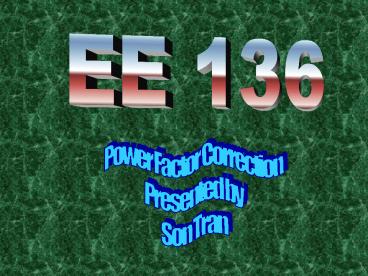EE 136 PowerPoint PPT Presentation
1 / 11
Title: EE 136
1
EE 136
Power Factor Correction Presented by Son Tran
2
Presentation Outline
- Introduction to PFC
- Discuss Passive PFC method
- Discuss Active PFC method
- Conclusion
3
PFC Definition
- Power factor is defined as the ratio of the true
power dissipated in the load to the apparent
power taken by the load - PF (true power)/(apparent power)
- When the current or voltage is not a true sine
wave, it is said to be distorted, then power
factor is less than unity
4
Typical Circuits Have Power Loss
Figure 4
Figure 5
5
Passive PFC
Power Factor 48.5
Power Factor 94
6
The circuit functions as following
Nmin (106Vc)/(4.44fBAc) Where for
laminated iron cores, Vc Vin 25Vin F
line frequency, Hz (typically 50Hz or 60Hz) B
maximum flux density, T (typically 1.3T) Ac
effective core area, mm2
f1MHz
Passive LRC input filter for harmonic reduction
f50Hz
7
The Valley-Fill Circuit functions as follow
Power Factor 98
8
Another Passive PFC Circuits
According to Power Factor Correction
Testing, (http//www.prodigit.com/e307.htm) F
igure 2 input terminal inductance working
frequency is power source frequency (50/60
Hz), due to the fact that inductor can soften the
current sudden change, therefore the input
current waveform will be smoother. Figure 3 is
using partly smoothen circuitry structure,
to improve power factor.
PF 98
Figure 2 Figure 3
9
Active PFC Method
- Key Requirements for a Boost PFC Control IC
- 1. Control switching of Q1 to maintain a good
input current waveform - For boost to be continuous, Voltage C1 must
exceed the input voltage at all time, so IC must
control to maintain the output voltage constant - If Output voltage maintain constant and load
changes, Io and Po change, thus input rms current
must change to keep Pin Po. Hence, IC must
adjust the longer term input rms current in
response to load changes - If Ro and Vo remain constant for a period, then
Io and Po remain constant for this period.
However, if Vin changes during this period, then
to maintain a constant input power, the I(in)rms
must again change. Hence, IC must ajust the mean
input current to compensate for any longer term
input voltage changes.
10
Conclusion
- Passive power factor correction method will bring
the power factor from less than 60 up to 98. - Passive PFC circuits is used for the low power
application. - For the high power application, the active power
factor correction method will work better. - Active PFC method can bring the power factor up
to 99.
11
Question?
- Good Luck for your final !!!
- Merry Christmas and Happy New Year!!!!

